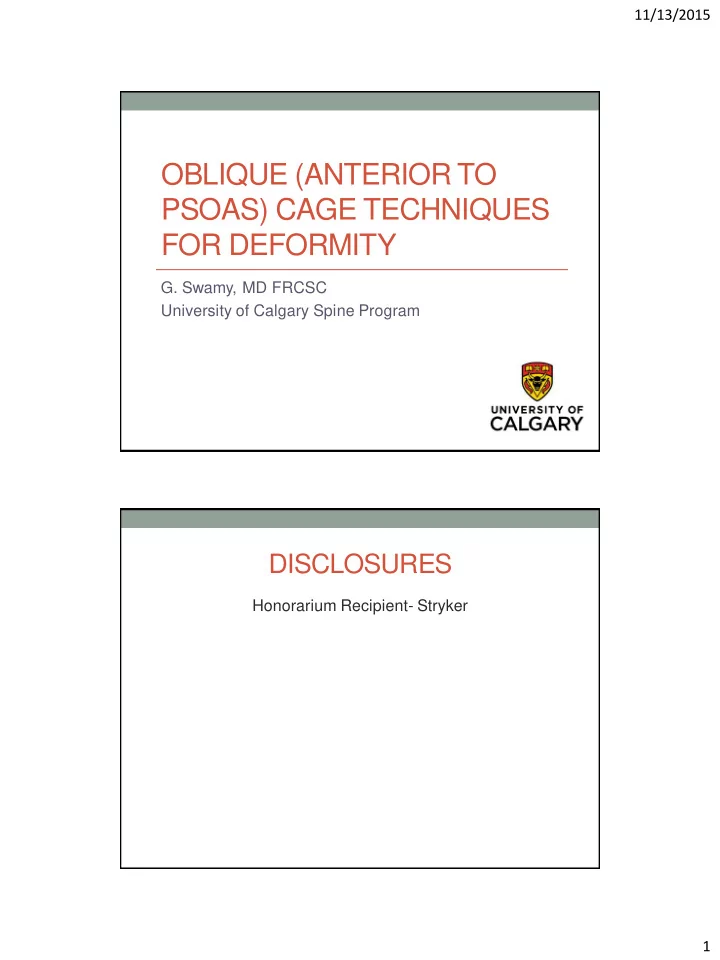

11/13/2015 OBLIQUE (ANTERIOR TO PSOAS) CAGE TECHNIQUES FOR DEFORMITY G. Swamy, MD FRCSC University of Calgary Spine Program DISCLOSURES Honorarium Recipient- Stryker 1
11/13/2015 Oblique Interbody Fusions • Define: Anterior retroperitoneal lumbar discectomy and cage insertion • Exploits plane to left of aorta, and anterior to psoas (ATP) • Main rationale – avoid trans-psoas dissection Oblique Cage Techniques for Deformity • Lateral cages are helpful Agenda in adult deformity • Brief history of anterior • Does the oblique cage retroperitoneal surgery offer substantive • Rationale for anterior differences between oblique work in adult LLIF? spinal deformity • Examine • Technical points • Oblique fusions mobile • Complications lumbar spine • Cases • Oblique approach to L5-S1 2
11/13/2015 Anterior Spinal Surgery 1956 CORR 1934 JBJS • Credits lumbar retroperitoneal approaches to kidney approaches (Digby 1941) Anterior Spinal Surgery 3
11/13/2015 Adult Spinal Deformity Surgery 1970s 1973 CORR 1975 JBJS 1981 JBJS Adult Deformity Surgery 1980s/1990s 4
11/13/2015 Adult Deformity Surgery – Posterior Only MIS Deformity Stage I • LLIFs L1-2, 2-3, 3-4, 4-5 • L3-4 and up: chest wall impedes access • Osteotomize ribs in line with spine • Diaphragm perforated (and sewn) for tube • Chest tube postop X 36 hrs Stage II • L5-S1 TLIF, T11-Ilium • Hybrid open TL, MIS L2- S1 • V. small concave apical pedicles - left • Coronal plane bend built back in for balance 5
11/13/2015 Technical problems with LLIF in deformity Dealing with high iliac crest and ‘deep - seated’ L4 -5 1. Hip pain or cruralgia 2. Nerve injuries 3. Inadequate lordosis 4. • Place cages anteriorly • Need for ACR Inability to access L5-S1 from lateral approach 5. Deep-seated L4-5 Very painful – far out of the ordinary Did 2. Never again. 6
11/13/2015 Iliac crest osteotomy Deep-seated L4-5 Answers • Angled implants (can’t see disc preparation directly) • Iliac osteotomy (pain) • Oblique approach 7
11/13/2015 Deep-seated L4-5 Cage goes in obliquely, but can be manoevered to lie transversely R.A. Hynes From Chapter 34, Surgical Approaches to the Spine, 3 rd Ed, Springer 2015 Hip Pain after LLIF • Femoral nerve • Obturator nerve injuries • LFCN injuries • Genitofemoral nerve injuries • Cummock et al JNS 2013 • 64% postoperative symptoms • By 3 months, more than ½ of these resolve • By 1 year, 90% resolve • Lee et al Spine J 2013 • Hip flexion strength decreased for first 2 / 52 postop • No differences afterwards 8
11/13/2015 Hip pain after LLIF • Can be a great source of discomfort • In our experience, large psoas (young men and women) means more postoperative thigh discomfort • Avoiding going through psoas altogether may be useful Nerve injury and LLIF • In over 600 cages, we have had no permanent motor palsies – MEPs and SSEPs used • Have had 3 late quads palsies (after 2 nd stage instrumentation) – in conjunction with SPO in 2 cases • 4 or 5 L4-5 levels abandoned – no reasonable place to dock • (Importance of blunt finger dissection through psoas) • Lykissas 2013 (n=453 patients, 919 levels) • 9.6% permanent sensory deficits • 2.3% permanent motor deficits 9
11/13/2015 How do nerve injuries occur? • Uribe 2015 • Retraction time at L4-5 • Coincident increase in t-EMG threshold • Bendersky 2015 – rigorous electrode positioning, including upper lumbar roots • Answer if alert: Move retractor anteriorly How do nerve injuries occur? Davis TT – JSDT 2015 10
11/13/2015 How do nerve injuries occur? Retraction of blades on femoral nerve Staying anterior to psoas avoids the problem. Inadequate Lordosis • Can LLIF restore lordosis? 11
11/13/2015 Inadequate lordosis • Literature is mixed • Sembrano 2014 • Acosta 2011 • Kepler 2012 • Anterior cage placement best • Kepler 2012 • Sridharan (submitted for publication) Inadequate Lordosis - ACR From Akbarnia et al 2013 12
11/13/2015 Potential complications – oblique approaches • Sympathetic injury • Vessel injury • Iliolumbar vein • Inadvertant anterior annulus and ALL resection • Dural tear Case – Painful Adult Idiopathic Scoliosis 13
11/13/2015 Case – Painful Adult Idiopathic Scoliosis 3 mg rhBMP2 / level Percutaneous posterior lumbar Open thoracic Complications: Ileus Edema Transaminitis (hx of EtOH) Doing well Case – Rapidly progressive deformity after intrathecal narcotic pump / syrinx Symptoms Intractable LBP R leg pain Not flexible PMHx Syrinx Chiari Narcotic pain pump 14
11/13/2015 Case – Rapidly progressive deformity after intrathecal narcotic pump / syrinx Anterior stage uncomplicated x hours y EBL Posterior stage missing 10 deg required PSO x hours y EBL z complications Pt doing well Case – Previous fusion, now painful TL curve with distal degeneration Fused to L2 L4-5 very oblique and deep First stage OLIF L L4-5 and L5-S1 LLIF R L2-3 and 3-4 15
11/13/2015 Case – Previous fusion, now painful TL curve with distal degeneration 16
Recommend
More recommend